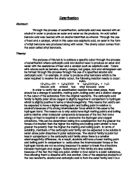-
A catalyst such as an iron catalyst is used to speed up the reaction by lowering the so that the N2 bonds and H2 bonds can be more readily broken.
-
Increased temperature means more reactant molecules have sufficient energy to overcome the energy barrier to reacting (activation energy) so the reaction is faster at higher temperatures (but the yield of ammonia is lower as discussed above).
A temperature range of 400-500oC is a compromise designed to achieve an acceptable yield of ammonia (10-20%) within an acceptable time period.
At 200oC and pressures above 750atm there is an almost 100% conversion of reactants to the ammonia product.
Since there are difficulties associated with containing larger amounts of materials at this high pressure, lower pressures of around 200 atm are used industrially.
By using a pressure of around 200atm and a temperature of about 500oC, the yield of ammonia is 10-20%, while costs and safety concerns in the building and during operation of the plant are minimised
- During industrial production of ammonia, the reaction never reaches equilibrium as the gas mixture leaving the reactor is cooled to liquefy and remove the ammonia. The remaining mixture of reactant gases is recycled through the reactor. The heat released by the reaction is removed and used to heat the incoming gas mixture.
The uses of ammonia
The farmers use ammonia as fertilizers on their fields, (which accounts for 90% of the nitrogenous fertilizers used). Nitric acid is a product of ammonia and is used in the production of explosives. Ammonia is a major chemical used in many of the households for cleaning. Straight ammonia, or ammonia mixed in window cleaners, floor cleaners are present in most homes. Refrigerators use ammonia as a cooling agent.
The Haber process is used to manufacture ammonia from nitrogen and hydrogen. Ammonia could then be used to make nitric acid, which reacts with ammonia to create ammonium nitrate, which is a very important fertilizer.
The raw materials for creating ammonia are air for nitrogen (N2 (g)) and methane and water for hydrogen (H2 (g)).
Hydrogen is process by taking methane (CH4 (g)) and reacting it with steam (H2O (g)) and thus creating carbon dioxide (CO2 (g)) and hydrogen (H2 (g)).
The nitrogen (N2 (g)) is obtained from the air by fractional distillation, because the air is made up of 80% nitrogen.
Fractional distillation is where they take a substance with another substance mixed together, and since both substances have different boiling points, they heat up the mixture. When the one substance with the lowest boiling point starts to boil it evaporates into a cooling jacket, which then liquidifies and is poured into a beaker or container. Then the next substance starts to boil and does the same thing except the substance is put into a different beaker or container to store it. And this separates all of the components of mixtures and you can get one or more pure substances out of a mixture.
The temperature and pressure are chosen to obtain a good yield of ammonia in a short time. This involves a compromise between maximum yield and speed of reaction. As you can see from the graph, ammonia yield is increased by very high pressures, but decreased by very high temperatures.
Advantages of the Haber process:
- You can make fertilisers i.e. nitric acid is used to react with ammonia to produce ammonium nitrate.
- Ammonium is reacted with sulphuric acid to produce ammonium sulphate.
- In the rivers fertilisers does the same, the river plants grow and algae grows rapidly, because of the abundant food supply.
- If the pressure is high and the reaction speed up it effectively increases high concentration.
- If the pressure is low and the reaction goes slow it effectively decreases and low concentration.
- The reaction at a low temperature it is an exothermic reaction favoured by low temperature, but this may produce too slow a rate of reaction.
Disadvantages of the Haber process
- Requires a lot of electricity and that costs money.
- After applying the fertiliser and it rains, or too much fertiliser is used it gets into stream or rivers and pollutes them.
- The algae then die in large numbers.
- And the bacteria feeding on the dead plants then use up a lot of the oxygen in the water.
- Fishes may then die because of the lack of oxygen in the water.
- Also too high of nitrates in the drinking water is a health hazard, particularly with infants.
- Nitrate can interfere with the flow of oxygen in the blood stream.







